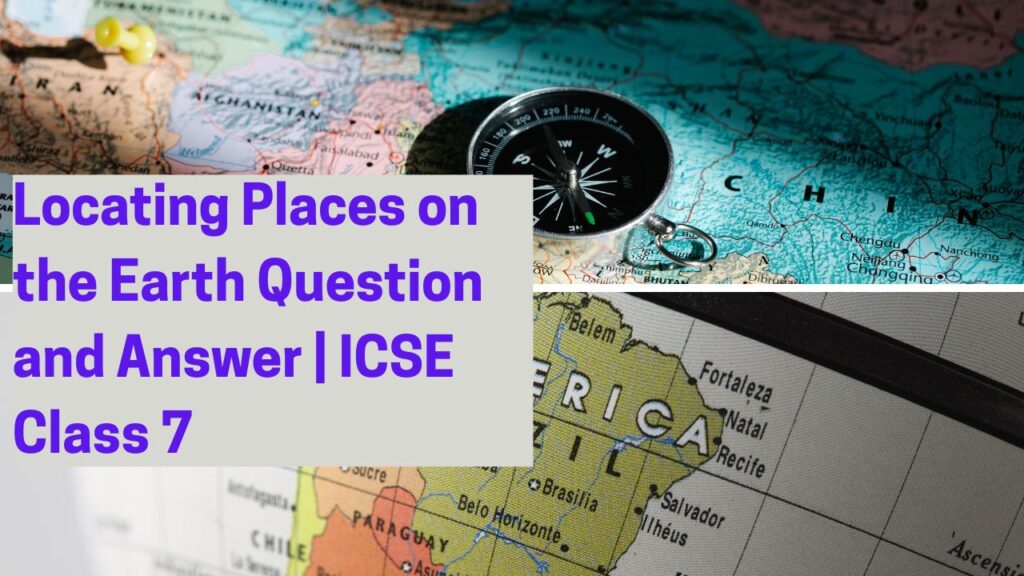This page contains important The Realms of the Earth ICSE Class 7 Questions and answers to help students grasp the concept easily. The chapter explains the four major realms of the Earth—lithosphere, hydrosphere, atmosphere, and biosphere. These solved Q&As are prepared to simplify the concepts and aid Class 7 students in their exam preparation and understanding of Geography.
A. Match the columns:
1: Spring tide → b: Full moon
2: Crest → a: Wave
3: Sial → d: Continental crust
4: Ozone → e: Stratosphere
5: Marble → c: Metamorphic rock
B. Write True or False:
1: The temperature inside the Earth decreases with an increase in depth: False
2: Sedimentary rocks are formed due to the cooling and solidification of magma: False
3: The movement of ocean water in the form of a stream is called the water cycle: False
4: Oxygen is found in the lower layer of the atmosphere because it is a heavy gas: True
5: Pollution needs to be checked so that the delicate balance of nature can be maintained: True
Major Landforms and Water Bodies of the Earth
The Best and Worst Experiences in School Essay
C. Give reasons for the following:
1: We cannot get direct information about the interior of the Earth.
Ans: The interior of the Earth is extremely hot and under immense pressure. No human-made instrument can withstand such extreme conditions. Hence, direct exploration of the Earth’s interior is impossible, and scientists rely on indirect sources such as seismic waves, volcanic eruptions, and deep drilling to study it.
2: Neap tides occur on a half-moon.
Ans: Neap tides occur when the Sun, Earth, and Moon form a right angle, which happens during the first and third quarters of the moon (half-moon phases). The gravitational pull of the Sun and Moon counteract each other, causing tides that are lower than usual.
D. Answer the following questions:
1: Distinguish between Crust and Core.
Crust:
a. The crust is also called the lithosphere, which is the solid outer layer of the Earth.
b. The upper part of the crust is called the continental crust, and the lower part is called the oceanic crust.
c. The density of the crust is about 3 grams per cubic centimeter.
Core:
a. The core lies below the mantle and around the center of the Earth.
b. It is made up of dense and heavy metals such as nickel and iron.
c. The average density of the core ranges between 5 g/cm³ and 13 g/cm³.
2: What are rocks? Name the main types of rocks with two examples of each.
Ans: Rocks are aggregates of minerals. They do not possess a definite chemical composition. Minerals, on the other hand, are naturally occurring solid substances present in rocks.
The three main types of rocks are:
a. Igneous Rocks – Formed by the cooling and solidification of magma.
Examples: Granite, Basalt.
b. Sedimentary Rocks – Formed by the deposition and compression of sediments.
Examples: Sandstone, Coal.
c. Metamorphic Rocks – Formed when existing rocks undergo changes due to heat and pressure.
Examples: Marble, Slate.
3: What are the causes for the occurrence of tides and ocean currents?
Ans: The causes of tides and ocean currents include:
a. Gravitational pull of the Sun and the Moon.
b. Prevailing winds that drive surface currents.
c. Differences in temperature and salinity of ocean water.
d. Variations in ocean water density due to different levels of heating by the Sun.
4: Explain the working of the hydrological cycle with the help of a neatly labeled diagram.
Ans: The hydrological cycle, or water cycle, describes the continuous movement of water between the Earth’s surface and the atmosphere.
- Water from oceans, rivers, and lakes evaporates into the atmosphere due to the Sun’s heat.
- Water vapor cools and condenses to form clouds.
- Clouds lead to precipitation in the form of rain, snow, or sleet.
- Water returns to water bodies through runoff and infiltration into the ground, completing the cycle.
(Note: Add a labeled diagram of the water cycle if required.)
5: Define atmosphere. Name the different layers of the atmosphere and their extent.
Ans: The atmosphere is the thin layer of gases surrounding the Earth. It extends from sea level up to 1,600 km above the Earth’s surface.
The five layers of the atmosphere are:
a. Troposphere – Extends 8 km over the poles and 18 km over the equator. It contains most of the Earth’s weather.
b. Stratosphere – Extends up to 50 km from sea level. It contains the ozone layer, which absorbs harmful UV rays.
c. Mesosphere – Extends from 50 km to 80 km. Meteors burn up in this layer.
d. Thermosphere – Extends from 80 km to 400 km. It contains the ionosphere, which reflects radio waves.
e. Exosphere – The outermost layer, gradually merging with space.
6: Mention three ways in which the atmosphere is useful to us.
Ans: The atmosphere is important because:
a. The lower layer of the atmosphere contains oxygen, which is essential for breathing.
b. It protects us from the harmful ultraviolet (UV) rays of the Sun.
c. It retains heat, keeping the Earth’s surface warm even at night.
7: What is the biosphere? Name the elements of the biosphere.
Ans: The word “biosphere” comes from the Greek word “bios” (life) and the Latin word “sphaira” (sphere). The biosphere is the sphere of living organisms, where the lithosphere, hydrosphere, and atmosphere interact to support life.
The elements of the biosphere include:
a. Plants
b. Animals
c. Human beings
d. Microbes


